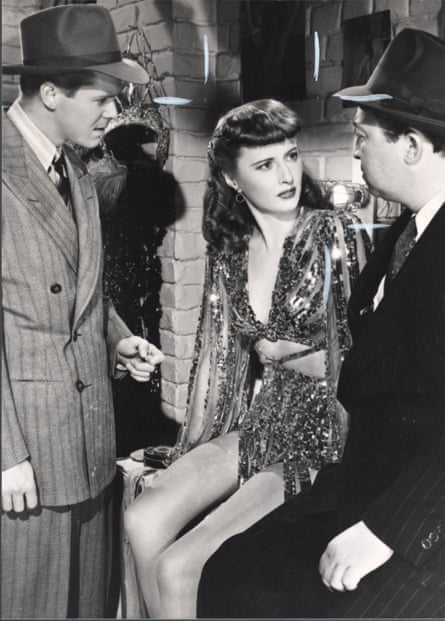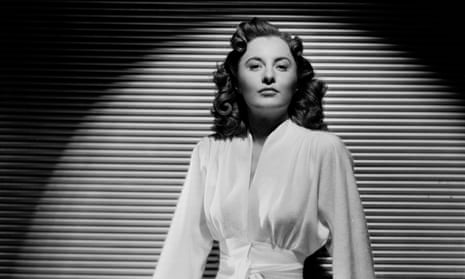Even Barbara Stanwyck struggled to pin down her appeal. “What the hell,” she blustered at critic Rex Reed, when he asked her to take a stab. “Whatever I had, it worked, didn’t it?” She was right, of course, and you can forgive her inarticulacy. Stanwyck – who is the subject of a BFI season, Starring Barbara Stanwyck – was not just unusually streetsmart and independent for a Hollywood star of the golden age, but superbly versatile, too.
Many of her directors tried to put the magic into words. “Stanwyck doesn’t act a scene. She lives it,” said Frank Capra, who directed her in the early 1930s breathtaking emotional films such as The Miracle Woman and Forbidden. For Billy Wilder, who directed her in ice-cold noir Double Indemnity, it was simple: “She was the best.” Perhaps Sam Fuller, who gave her a memorable late film role as a fearsome rancher in Forty Guns, summed up the Stanwyck touch most completely as “the happy pertinence of professionalism and emotion”. She could summon performances that were as still and steady as Bogart or Mitchum.
Born Ruby Stevens in Brooklyn in 1907 and raised first by her big sister and then in a series of foster homes after her mother died and her father left, Stanwyck consistently downplayed the privations of her childhood. “Foster homes in those days weren’t cruel,” she said, “just impersonal.” But she did eventually admit that her background influenced her work. “I’m a product of crowded places and jammed-up emotions,” she said, “where right and wrong weren’t always clearly defined and life wasn’t always sweet, but it was life.” After a stint dancing on Broadway, Stanwyck headed for Hollywood.
The first Stanwyck role that made the critics sit up and take notice was 1930’s Ladies of Leisure, a Capra romance in which she plays a gold-digging good-time girl who falls for a rich artist but resolves to give him up for the sake of his family. You haven’t seen the full force of her early talent, however, until you have seen her in the jawdropping 1933 pre-Hays code Baby Face. Stanwyck plays Lily Powers, a young woman who takes revenge on a cruel world by hustling to the top of New York society using raw sex appeal and a ruthless, Nietzschean philosophy.
Stanwyck’s best role of the 30s came in maternal melodrama Stella Dallas (1937), adapted from Olive Higgins Prouty’s popular novel. It’s a magnificent film, closely modelled on the silent version starring Belle Bennett, and featured Anne Shirley as Stanwyck’s daughter, who is increasingly mortified by her brash, working-class mother. Stanwyck had never been vain about her looks (“average nice-looking” was the most she would allow) and she wasn’t afraid to embrace the padded, gaudy frocks, cotton-wool jowls and floozy manners that made Stella unattractive, before tearing the audience’s hearts to pieces in the rain-soaked finale. “Stella had to appear loud and flamboyant – with a touch of vulgarity,” Stanwyck said. Stella Dallas was a triumph, and earned Stanwyck her first best actress Oscar nomination. She would be nominated three times more, but would never get her hands on a statuette until she was given an honorary prize in 1982, eight years before her death.

Stanwyck’s next Oscar nod came for Ball of Fire (1941), directed by Howard Hawks and inspired by Disney’s seven dwarfs, in which she played Sugarpuss O’Shea, a slangy cabaret singer caught between the mob and a gaggle of bewildered professors. That wasn’t even the best comedy she released that year. It’s a tough call, but Preston Sturges’s witty and outrageous The Lady Eve, which pitted Stanwyck’s con artist against Henry Fonda’s scientifically inclined brewery heir, just edges it.
Stanwyck’s final Oscar-nominations came for two noir roles. The last was for playing the tormented and bedridden Leona in 1944’s Sorry, Wrong Number, but first came Double Indemnity, and her lethally captivating femme fatale Phyllis Dietrichson. She gave Phyllis – bedecked with lacquer-hardened platinum waves and that infamous slinky ankle bracelet – shameless sex appeal as she traded peerless innuendo with co-star Fred MacMurray.
Having proved she could turn villain, and that she was tough enough for the most brutal or cynical of thrillers, Stanwyck’s range grew. There were more noirs, more of her beloved westerns (including 1950’s The Furies and 1955’s The Violent Men), and a brace of lesser-sung Douglas Sirk melodramas that make hay out of Stanwyck’s increasingly starry, glamorous persona. In All I Desire (1953), she plays a famous actor, in There’s Always Tomorrow (1956) a ritzy fashion designer, but in both films the plot allows her and her charisma to breeze back into a small town and cause emotional havoc by rekindling old flames and sparking old rivalries. The final 20 minutes of There’s Always Tomorrow in particular are a masterclass in melodramatic acting, as raw as anything she did for Capra, but powerfully restrained. As Stanwyck grew older, and her growl of a voice grew deeper, she would collect Emmys for her TV work, from her own anthology show to western series The Big Valley and later The Thorn Birds and The Colbys.
Femme fatale, cattle rancher, screwball comedian or melodrama queen: Stanwyck inhabited them all, but her best characters were always fighters who had tasted the bitterness of life. It’s that sense of hard-won authenticity that defines the Stanwyck brand, too. “I’m a tough old broad from Brooklyn,” she said. “Don’t try and make me into something I’m not.”
Starring Barbara Stanwyck runs at BFI Southbank in February and March. The Lady Eve is on limited release from 15 February. Barbara Stanwyck in the Spotlight, a day of talks and discussions, takes place at BFI Southbank on 2 February

Comments (…)
Sign in or create your Guardian account to join the discussion